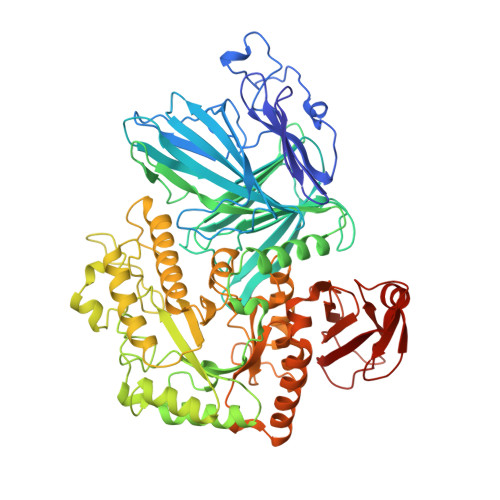Agask, a Bifunctional Enzyme from the Human Microbiome Coupling Galactosidase and Kinase Activities
Bruel, L., Sulzenbacher, G., Tison-Cervera, M., Pujol, A., Nicoletti, C., Perrier, J., Galinier, A., Ropartz, D., Fons, M., Pompeo, F., Giardina, T.(2011) J Biol Chem 286: 40814
- PubMed: 21931163
- DOI: https://doi.org/10.1074/jbc.M111.286039
- Primary Citation of Related Structures:
2YFN, 2YFO - PubMed Abstract:
α-Galactosides are non-digestible carbohydrates widely distributed in plants. They are a potential source of energy in our daily food, and their assimilation by microbiota may play a role in obesity. In the intestinal tract, they are degraded by microbial glycosidases, which are often modular enzymes with catalytic domains linked to carbohydrate-binding modules. Here we introduce a bifunctional enzyme from the human intestinal bacterium Ruminococcus gnavus E1, α-galactosidase/sucrose kinase (AgaSK). Sequence analysis showed that AgaSK is composed of two domains: one closely related to α-galactosidases from glycoside hydrolase family GH36 and the other containing a nucleotide-binding motif. Its biochemical characterization showed that AgaSK is able to hydrolyze melibiose and raffinose to galactose and either glucose or sucrose, respectively, and to specifically phosphorylate sucrose on the C6 position of glucose in the presence of ATP. The production of sucrose-6-P directly from raffinose points toward a glycolytic pathway in bacteria, not described so far. The crystal structures of the galactosidase domain in the apo form and in complex with the product shed light onto the reaction and substrate recognition mechanisms and highlight an oligomeric state necessary for efficient substrate binding and suggesting a cross-talk between the galactose and kinase domains.
Organizational Affiliation:
Faculté des Sciences et Techniques Saint-Jérôme, Université Paul Cézanne, ISM2/BiosCiences UMR CNRS 6263, service 342, 13397 Marseille Cedex 20, France.




















